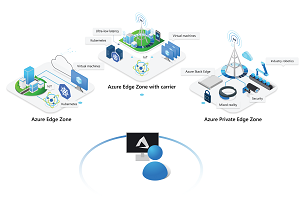News
New Azure Edge Zones Will Offer Ultra-Low-Latency Edge Computing, Development
Microsoft is previewing Azure Edge Zones, providing ultra-low-latency edge computing to enable new scenarios for developers, customers, and partners.
"Azure Edge Zones is a family of offerings from Microsoft Azure that enables data processing close to the user," Microsoft documentation states. "You can deploy VMs, containers, and other select Azure services into Edge Zones to address the low latency and high throughput requirements of applications."
The company said the new Azure Edge Zones preview offering combines the capabilities of Azure, 5G, carriers and technology partners to enable those new scenarios, allowing for:
- New frontiers for developers working with high-density graphics and real-time operations in industries such as gaming and mobile platforms.
- Local data processing for secure workloads, latency-sensitive data analytics, IoT, and media services.
- Real-time IoT and AI analytics for optimizing, building, and innovating for robotics, mixed reality, and automation tools.
Getting more granular, Microsoft documentation lists typical use case scenarios such as:
- Real-time command and control in robotics
- Real-time analytics and inferencing with artificial intelligence and machine learning
- Machine vision
- Remote rendering for mixed reality and VDI scenarios
- Immersive multi-player gaming
- Media streaming and content delivery
- Surveillance and security
 [Click on image for larger view.] Azure Edge Zones (source: Microsoft).
[Click on image for larger view.] Azure Edge Zones (source: Microsoft).
Azure Edge Zones actually comes in three different offerings:
- Azure Edge Zones: These are small footprint extensions of Azure located in population centers distant from Azure regions. Typical use cases here include:
- Gaming and game streaming
- Media streaming and content delivery
- Real-time analytics and inferencing using artificial intelligence and machine learning
- Rendering for mixed reality
- Azure Edge Zones with Carrier: These are small footprint extensions of Azure located in mobile operators' datacenters in population centers. Typical use cases here, in addition to the above, also include:
- Connected automobiles
- Telemedicine
- Azure Private Edge Zones: These are small footprint extensions of Azure placed on-premises, supporting basically all of the above, except Microsoft didn't list "immersive multi-player gaming" and "media streaming and content delivery" in this sector.
One use case scenario sees developers building optimized and scalable applications using Azure and directly connecting to 5G networks by building upon previously announced integration with AT&T to enable next-generation solutions on the edge, leveraging consistent Azure APIs and tooling in the public cloud.
"We were the first public cloud to announce 5G integration with AT&T in Dallas in 2019, and now we're announcing a close collaboration with AT&T on a new Edge Zone targeted to become available in Los Angeles in late spring," said Azure Networking exec Yousef Khalidi in a March 31 blog post.
The first edge zones will be available in June, Microsoft said.
Anyone wishing to join the Azure Private Edge Zone preview can go here.
About the Author
David Ramel is an editor and writer for Converge360.